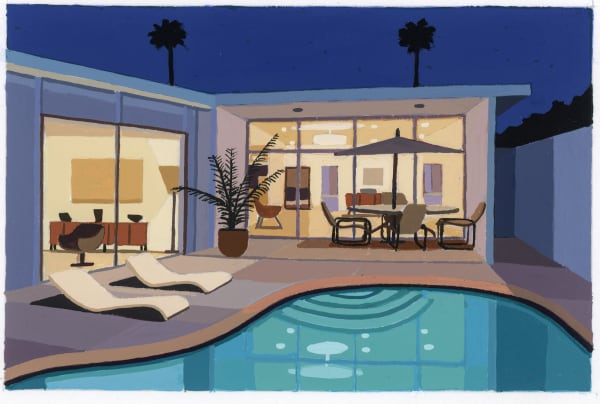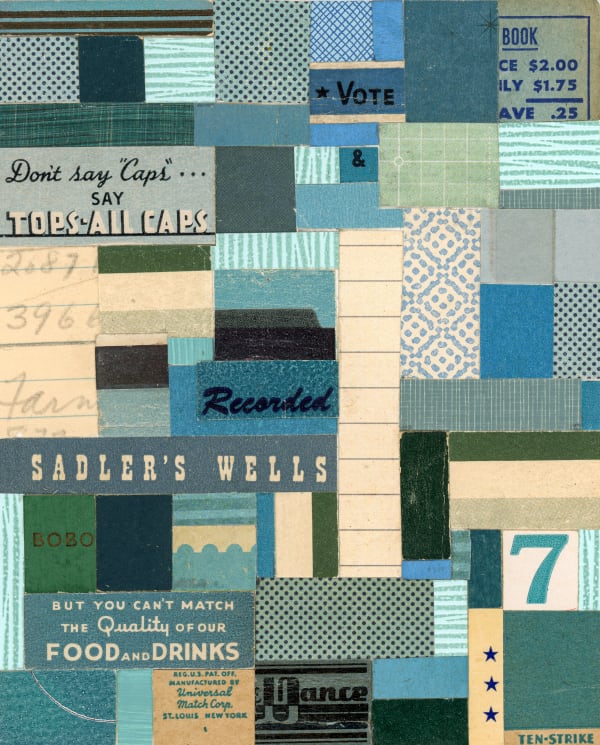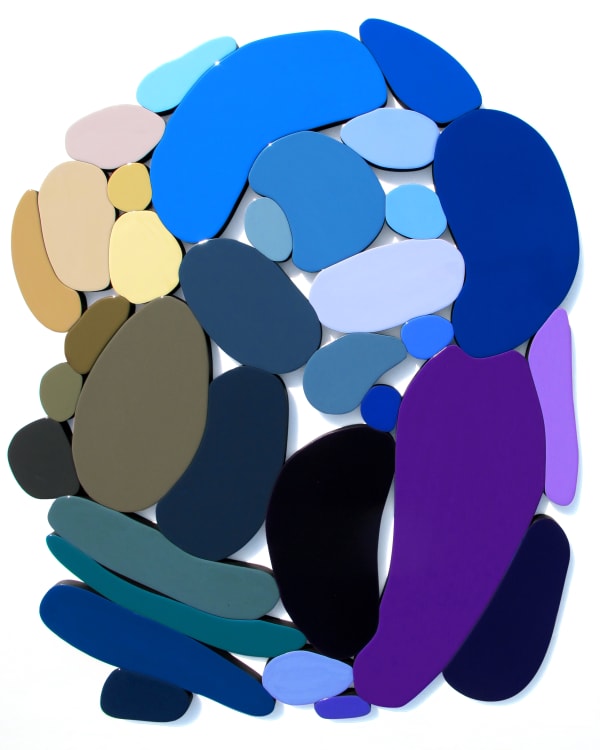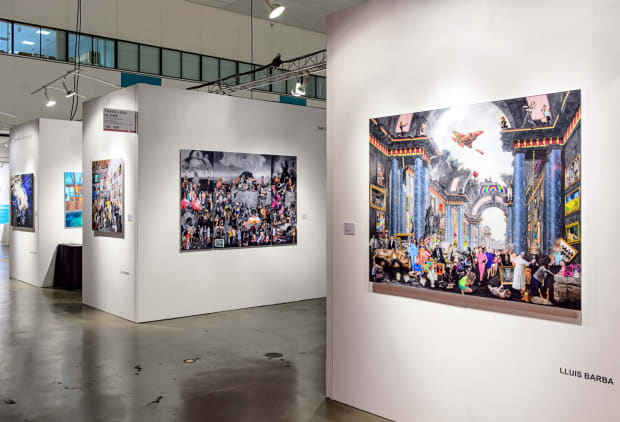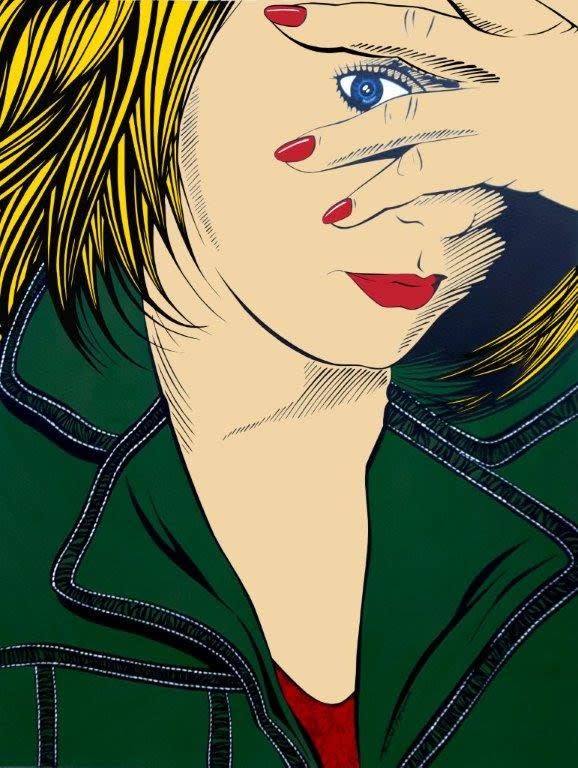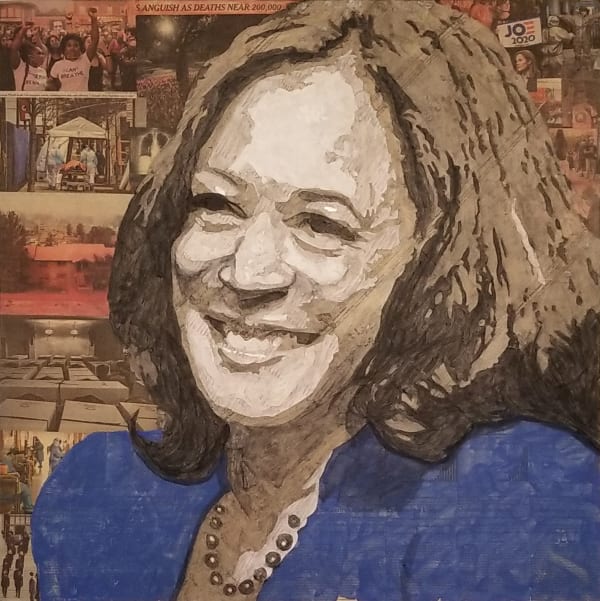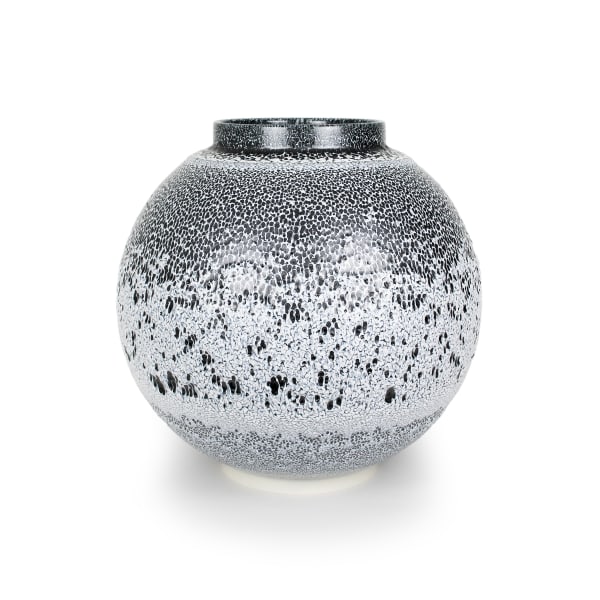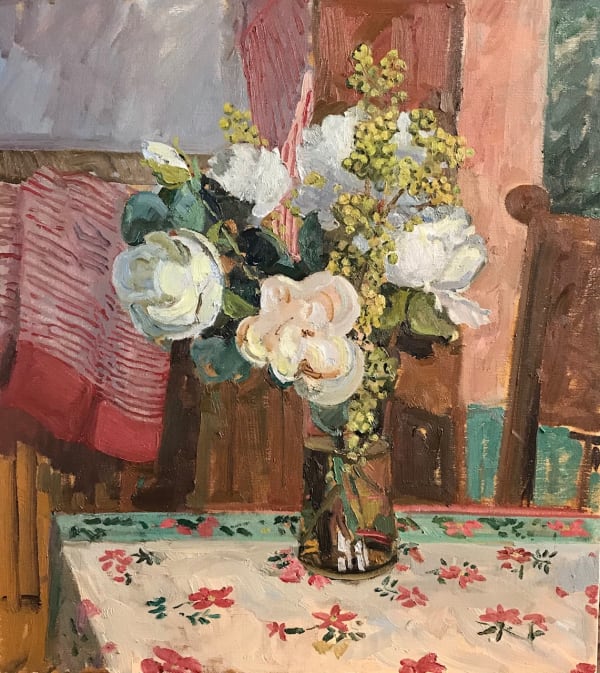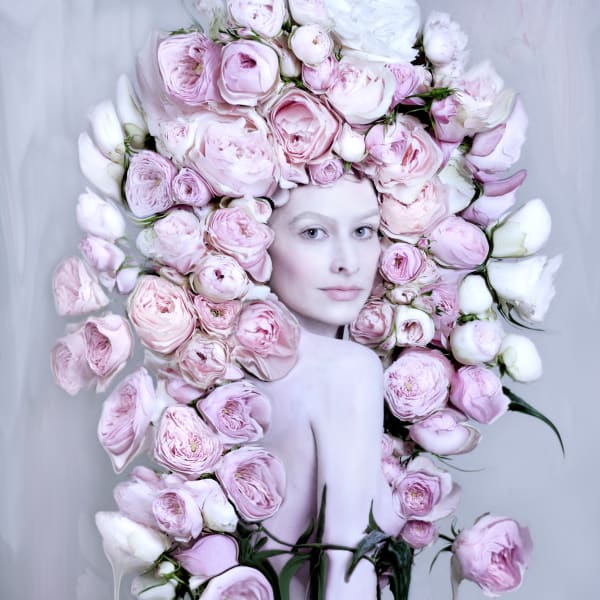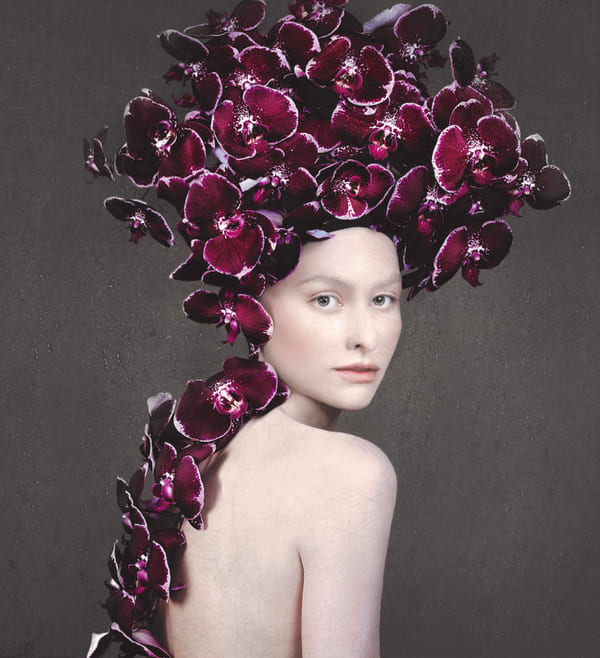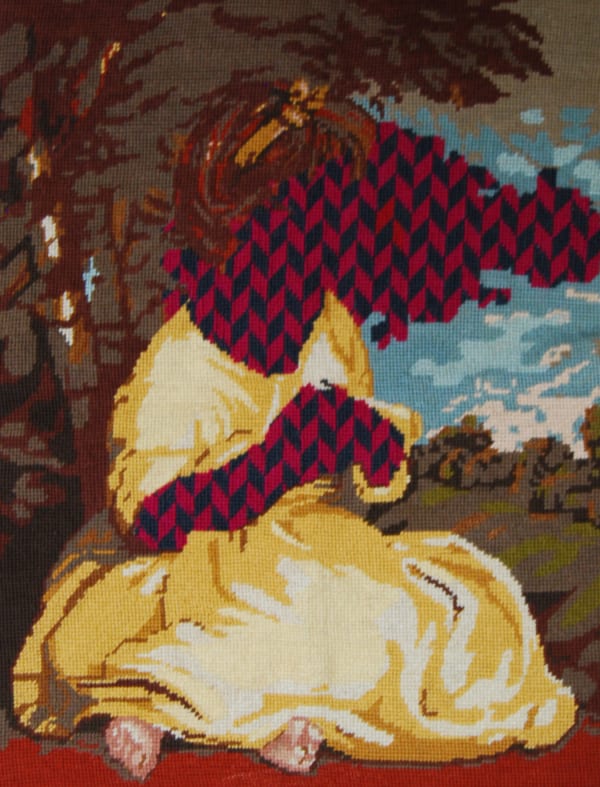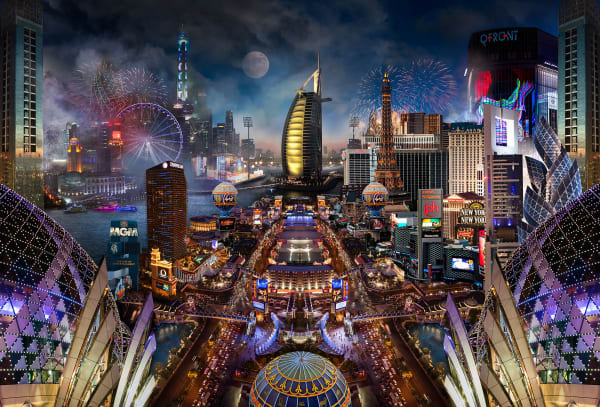-
Cynthia Corbett Gallery is thrilled to be back at Art Miami 2020 for our 11th year in a row. We are pleased to present a curation of artworks by Gallery artists and Young Masters, entitled Tradition: Revisited. This special selection was created in the spirit of celebrating the art historical canon and the way our featured artists subvert and reflect upon it. From Deborah Azzopardi's optimistic Pop scenes to Andy Burgess's Modernist houses and Braque-esque abstract collages, from Klari Reis's Bauhaus-inspired sculptural pieces to Tom Leighton's architectural fantasies, we are proud to present a stunningly diverse variety of genre, medium, format and subject matter. Included in our presentation are three European photographers, whose commentary on contemporary subject matter range from Lluís Barba's social satire to Isabelle van Zeijl's reflection on the essence of beauty to Fabiano Parisi's melancholiac poetry of deserted villas and streets of Rome under lockdown.
In addition, continuing our mission of introducing new Young Master talent to Art Miami, we are delighted to present five extraordinary and very diverse artists: painters Kelly Carmody and Tuëma Pattie, Young Masters Maylis Grand Ceramic Art Prize alumni Albert Montserrat and Matt Smith as well as recovering lawyer turned artist Geoffrey Stein. Kelly Carmody's Impressionist-inspired and technically brilliant canvases are filled with gentle sunlight and a haunting mood. Tuëma Pattie's painterly Abstract Expressionism has recently gained international critical acclaim during her first career retrospective at the age of 82. Albert Montserrat's Korean glaze-moon jars and bowls are revered by ceramic enthusiasts and curators all over the world. Matt Smith's porcelain figurines and reclaimed textiles provide a reflection on museums, queerness and gender roles. US-based and British-trained Geoffrey Stein's painted collages are offering a multilayered and strong viewpoint (sometimes controversial) while capturing the zeitgeist with incredible elegance.
-

-
Lauded by Annabel Sampson, Deputy Editor of Tatler as “the next David Hockney” painter Andy Burgess, who hails from London but lives in Arizona, continues to expand upon his fascination with contemporary architecture. A new series of paintings on panel and canvas colourfully re-imagines iconic modernist and contemporary houses. Burgess selects the subjects for his paintings with the discernment of the portrait painter. Buildings are chosen for their clean lines, bold geometric design and dynamic forms. Burgess approaches his subjects with a fresh eye, simplifying and abstracting forms even further and inventing, somewhat irreverently, new color schemes that expand the modernist lexicon beyond the minimalist white palette and rigid use of primary colours. Real places are sometimes re-invented, the architecture and design altered and modified, with new furniture and landscaping and a theatrical lighting that invests the painted scene with a dream-like quality and a peaceful and seductive allure.
'Despite the huge impact of early modern architecture, the innovative and subtle minimalist buildings that I am researching, with their concrete and steel frames, flat roofs and glass walls, never became the dominant mode of twentieth century building. We have continued to build the vast majority of houses in a traditional and conservative idiom, so that these great examples of modern architecture, designed by the likes of Gropius, Loos and Breuer to name but a few, are still shocking and surprising today in their boldness and modernity, almost a hundred years after they were built,' – Burgess says.
During 2020 Andy Burgess has reverted back to collages, which he has been making for 25 years. 'The playful and life-affirming nature of art is also intrinsic to my practice. I’m less inclined to make work that is self-consciously ironic or shocking, but rather I am drawn to the fact that color and shape produce very profound positive emotional reactions in the viewer. As such the subject of my art is human emotion, joy and the evocative nature of color and light and shape. My collage is an exploration in intuitive color combinations and the illusion of space within the two-dimensional artwork. I see my work as very much an engagement with the history and trajectory of modern art, the assertion of the artwork as an object in its own right rather than a window onto another world. By extension, my collage is also an exploration of other non-modern art forms such as primitive art, indigenous and folk art and even “Outsider” art (all of these have been hugely influential on modern art). In this way I can fabricate a collage that might be influenced by The St. Ives School of British modernists as well as the Gee’s Bend quilts made by African American women in an isolated part of Alabama. Collage encourages referencing and appropriation and allows for a dialogue across time and culture. My emigration over ten years ago from the metropolis of London to the desert South West of the USA has led to an interest in Native American and Mexican design and pattern. My recent collages have tended to mimic textiles and fabrics and make associations beyond the realm of fine art, to the aesthetic qualities of crafted objects such as rugs and clothing and even ceramics, ' – the artist says.
-
-
 Andy Burgess, Tropical House, 2019
Andy Burgess, Tropical House, 2019 -
 Andy Burgess, Lookout House at Dusk, 2020
Andy Burgess, Lookout House at Dusk, 2020 -
 Andy Burgess, Summer House With Red Loungers, 2020
Andy Burgess, Summer House With Red Loungers, 2020 -
 Andy Burgess, Ridgeline House, 2020
Andy Burgess, Ridgeline House, 2020 -
 Andy Burgess, Quiet Space, 2020
Andy Burgess, Quiet Space, 2020 -
 Andy Burgess, Desert Villa Retreat, 2020
Andy Burgess, Desert Villa Retreat, 2020 -
 Andy Burgess, Tropical House with Illuminated Pool, 2020
Andy Burgess, Tropical House with Illuminated Pool, 2020 -
 Andy Burgess, Casa Rubens de Mendonça, 2020
Andy Burgess, Casa Rubens de Mendonça, 2020 -
 Andy Burgess, Two Suits, 2020
Andy Burgess, Two Suits, 2020 -
 Andy Burgess, Sailing, 2020
Andy Burgess, Sailing, 2020 -
 Andy Burgess, Pizzicato, 2020
Andy Burgess, Pizzicato, 2020 -
 Andy Burgess, Sadler's Wells, 2020
Andy Burgess, Sadler's Wells, 2020 -
 Andy Burgess, Borzoi Books, 2020
Andy Burgess, Borzoi Books, 2020 -
 Andy Burgess, Correio, 2020
Andy Burgess, Correio, 2020
-
-

-
Klari Reis uses the tools and techniques of science in her creative process, constantly experimenting with new ways to apply materials and methods. She is driven by curiosity and her desire to explore and document the natural and unnatural with a sense of wonder and joy. Formally trained as an architect, the artist from her base in San Francisco (in proximity to one of the largest concentrations of life science/technology companies in the world) collaborates with local biomedical companies and is inspired by the cutting edge of biological techniques and discoveries.
The unifying theme of Klari Reis’s art is her mastery of a new media plastic, epoxy polymer, and the fine control she brings to its reactions with a variety of dyes and pigments. Her compositions display brightly coloured smears, bumps and blobs atop aluminum and wood panels. A skilled technician with a studio for a laboratory, Reis uses science in the service of her art.
Klari Reis's work has been exhibited worldwide and public collections include Microsoft Research in Cambridge, UK; Next World Capital’s offices in San Francisco, Paris, and Brussels; MEG Diagnostic Centre for Autistic Children in Oxford, UK; Great Ormond Street Hospital for Children in London; the Stanford University Medical Center Hoover Pavilion in California; and Elan Pharmaceuticals, Genentech, Acetelion and Cytokinetics in South San Francisco.
-

-
Lluís Barba constructs his huge photographs with minute attention to detail. During the last twenty years he has developed his distinctive iconography, each work including visual references as people, paintings and his own artworks are transferred to new compositions. Just as artists have for centuries teased their audience with allegory and symbolism, so Barba’s jigsaw of iconography presents a maze of allegorical pathways, the symbolism of the historical sources overlaid with that of the contemporary characters, reinforced by our own personal knowledge and experience and the gravitas afforded by column inches, art criticism and saleroom prices. In Barba’s work we can read the growth of celebrity currency, commentary on recent history and also his own personal reflections: like many historical artists, Barba’s work is also ultimately a giant autobiography. We see photographs of collectors or visitors gathered from trips to international art fairs, including images he has been asked to take by people viewing his own work; there are his motifs such as barcodes, imprinted on his characters; and the rainbows and flowers, his symbols of hope. Wry humour and ironic cross-references colour his visual commentary, as we are invited to navigate between images in the contemporary world, instantly recognisable art historical references and the ever-changing landscape of celebrity icons. When you stand in front of one of Barba’s enormous photographs you are literally in the space of the art as it spreads out before you, sometimes extending into the viewing space with flooring or sculptures spilling from the image.
Born in Spain and educated at the Escola Massana Centre d’Art, Barcelona, Barba has exhibited his work in the United States, Europe, Latin America and Canada. His work is held in major public collections and his private collections include, Jorge M. Pérez, Miami, Rick & Kathy Hilton, California and Wendy Fisher, London.
Lluís Barba was one of the first finalists of the inaugural 2009 Young Masters Art Prize in London. The artist exhibited at the European Pavilion of the 2017 Venice Biennale.
-

-
London-based Deborah Azzopardi acquired her worldwide fame for the joyous Pop Art images she has created over the past 35 years. Deborah’s unique and feminine take on contemporary art is best described by the esteemed art critic Estelle Lovatt. ‘America has Lichtenstein, we have Azzopardi!’ Lovett goes on to comment: “Sometimes you just want to curl up under a blanket. With a good book. A piece of chocolate. A man. This is what Deborah Azzopardi’s pictures make me feel like doing. They are me. They remind me of the time I had a red convertible sports car. I had two, actually. And yes, they are you, too. You immediately, automatically, engage with the narrative of Azzopardi’s conversational visual humour. Laughter is the best aphrodisiac, as you know. Never before has the erotic dream been painted by a woman so well. ... Distinctive, memorable and provocative, Azzopardi’s Pop Art shows what happens to the protagonist as her canvas acts like a storyboard for movies. Azzopardi’s definitely got the ‘When Harry Met Sally....’ – “I’ll have what she’s having” ... down to a fine art, in paint. ... There’s plenty of art historical references from... Manet’s suggestive ‘Olympia’; Boucher’s thought-provoking... ‘Louise O’Murphy’ and Fragonard’s frivolous, knickerless, ‘The Swing’.... Unique in approach, you easily recognise an Azzopardi picture. ... Working simple graphics and toned shading (for depth), the Pop Art line that Azzopardi sketches is different to Lichtenstein’s. Hers is more curvaceous. Feminine.”
The world is familiar with her artworks, as many of them have been published internationally. Her original paintings are in great demand, and we are pleased to bring to the marketplace such rare gems as the Habitat ‘Dating’ series (2004/08), the iconic Sshh (2008) and Love Is The Answer (2016), created by the artist at the request of Mitch and Janis Winehouse as a tribute to their daughter.
Deborah Azzopardi considers the artwork of the famous French artist and illustrator René Gruau as her major inspiration. Gruau started his career as Cirhstian Dior’s artistic director and was in a way responsible for the tremendous success of the New Look in 1947. Gruau’s women, languid, coquettish and elegant as well as his refined and economic use of line often become Azzopardi’s point de départ, while she develops her characters in a more outspoken manner.
-
-
 Deborah Azzopardi, Pure Gold, 2013
Deborah Azzopardi, Pure Gold, 2013 -
 Deborah Azzopardi, Delaying Technique, 2016
Deborah Azzopardi, Delaying Technique, 2016 -
 Deborah Azzopardi, Through My Eyes, 2017
Deborah Azzopardi, Through My Eyes, 2017 -
 Deborah Azzopardi, Sometimes Unpredictable 2, 2016
Deborah Azzopardi, Sometimes Unpredictable 2, 2016 -
 Deborah Azzopardi, I Spy With My Little Eye, 2016
Deborah Azzopardi, I Spy With My Little Eye, 2016 -
 Deborah Azzopardi, Female Intuition, 2016
Deborah Azzopardi, Female Intuition, 2016 -
 Deborah Azzopardi, I Just Called To Say..., 2020
Deborah Azzopardi, I Just Called To Say..., 2020 -
 Deborah Azzopardi, Physical Attraction 2, 2020
Deborah Azzopardi, Physical Attraction 2, 2020
-
-

-
Geoffrey Stein is a recovering lawyer, who has been painting full-time since 2000. He received a Certificate in Painting from the New York Studio School in 2004 and an MFA from the Slade School of Fine Art, London in 2007. Based between NYC and Connecticut, Stein lives, paints and does his signature collages in his homes and studio.
'In my studio practice I utilise collage as a formal element. It provides a way of putting down tone or erasing previous marks. There is a randomness in collage; the secondary meaning in the text or image becomes an important part of the finished work. Collage allows me to layer multiple images over the scaffolding of a drawing. I use materials from the subject's world to create their likeness. This is a modern take on the renaissance trope of putting objects into a portrait to illustrate the attributes of the subject, for example books to show the subject was educated. Instead of illustrating the attributes of the subject with a symbol, as a Renaissance era painter would, I collage the portraits with materials and text from the subject's world,' – says Stein.
His most recent collage portrait is of Dr. Anthony Fauci, using collage material from The New York Times and the Center for Disease Control in Atlanta. Stein comments, 'I began my collage of Dr. Fauci during the height of the Covid crisis in New York. It was a dark time. The number of sick and dying Covid patients continued to grow. ... Media photographs of healthcare workers caring for the sick and dying, and of people lined up for miles to get food, were heartbreaking. I used those dark images for the background of his portrait. ... To complete the portrait I glazed the collage with acrylic paint to develop the dark areas giving more form to Dr. Fauci's head.'
We are proud to introduce Geoffrey Stein's artworks to the Art Miami. -

-
Albert Montserrat is totally convinced that ceramics is the most noble, traditional and humanly attached material of all. Also, historically, what this material has allowed us, the humanity, to achieve, in all aspects, from improving our health to a medium of expression, is immense. This makes him feel real veneration and respect to it. He shows a very particular interest for the highly technically demanding oriental glazes from the Old Masters, having inspired him to make an extensive research, giving the strong finish to Montserrat’s work. Glazes are his passion. He is fascinated to see and endlessly test what the chemical elements around us bring to the surface of the vessels that he throws on the wheel. He has a special interest in the traditional vessels that the history of ceramics has brought to us. From the Egyptian canopic jars to the Roman amphoras or the Korean moon jars.
Montserrat has been intensively and continuously making ceramics for over ten years in Spain, Mexico and the UK. His work is held in public collections in Spain and the UK and in private collections in Qatar, USA, UK, Spain, Mexico, Australia, Belgium and France. He won the Barcelona’s Ceramics Biennial in 2018. Montserrat holds several internationally acclaimed awards: Highly Commended Young Masters Maylis Grand Ceramics Prize 2019 and Young Masters Lerouge Knight Art Award 2019.
-

-
Kelly Carmody, based in Massachusetts, is a guest artist of the Cynthia Corbett Gallery. She is inspired by the formal techniques of the Old Masters, and her work transports the traditional genres of portraiture and still life into the contemporary realm. Whether working on series of multiple figures in their environments and full-length portraits, or smaller, more intimate paintings of still-lives, Carmody strives to create compelling, powerful, and enigmatic depictions of everyday subjects. Kelly Carmody was the artist behind the paintings created by Amy March in Greta Gerwig's 2019 movie adaptation of Little Women.
-

-
Tuëma Pattie (b. 1938) was born in Dublin and studied at the Belfast College of Art, the Central School of Art and Design and Morley College, London, Piers Ottey and Christopher Baker in Sussex and Robin Child in Devon. In her days in Belfast and London, she took advantage of urban scenes as her subject matter. She then had a long period in which she took time out to have two children and to support her husband in his career. This meant it was difficult to find the time for her beloved painting, as was the case for many women in that era. With the move out of London in 1989, she did have the subsequent benefit of much foreign travel. Subject matter was carefully gathered with the resultant explosion of energy into her canvases, with paintings from the Galapagos, Antarctica, Spain, Italy and Uzbekistan as well as her beautiful West Sussex. It is from this period that she was able to develop into the world of experimental landscapes.
Tuëma Pattie has exhibited at the Royal Academy Summer Exhibition; the Royal Hibernian Summer Exhibition; the Cork Street Gallery; Art for Youth at the Mall Gallery London; London Art Fair; the Chichester Open; the Moncrief Bray Gallery, the Kevis House Gallery and the Rowntree Tryon Gallery all in Petworth; APPART; the East Hampshire Art Fair; the Jorgensen Gallery in Dublin and at Glyndebourne. She has recently had her first career retrospective with Cynthia Corbett Gallery at La Galleria, London, UK. “To me, painting has always been an opportunity to interpret imaginatively what I see in front of me. The facts are there – it is how one brings them to life that is the magic,” – the artist says. -

-
Fabiano Parisi began his career as a photographer following a degree in Psychology, coming to photography through a project photographing derelict asylums, which sparked his interest in the abandoned buildings which are the subject of his art practice today. He has two ongoing series: The Empire of Light and Il Mondo Che Non Vedo (The World I Do Not See). The latter title is taken from a collection of poems by Fernando Pessoa, a hint at the poetic qualities of Parisi’s work. What is so striking about Parisi’s work is his use of light, his relationship not just to history but to the theme of the ruin in Art History, and the composition and surface of his work. The power of Parisi’s work lies in the strength and command of his image-making, never straying from a strictly symmetrical approach, which allows the viewer to assume his viewpoint within the building, the wide-angle lens giving a sense of depth and breadth, without compromising on detail.
Parisi uses only natural light, shooting early in the morning. The colours and chiaroscuro are at their best at this time of day, and are left untouched by digital image manipulation software. Parisi’s photographs have an honesty and integrity that is part of what makes them so inviting. The artist often selects buildings with frescoed walls, which create an illusion of a painterly surface in his photographs and a textural sensibility that belies the photograph’s flat surface. His method highlights the patina of these forgotten places. The artist prints his work himself onto carefully chosen papers that enhance and maximise his colours and tones. Parisi has a strong relationship to Art History; the subject of the ruin was prevalent in the 18th and 19th Centuries, and interest is still strong today as evidenced by Tate Britain’s 2014 exhibition ‘Ruin Lust’. From painters such as Piranesi to Turner to Constable, Parisi is part of an important genre in art.
Parisi participated in the 54th Venice Biennale, Italian Pavilion and in Fotografia Festival Internazionale di Roma in 2012 at the Macro Museum. In 2010 he was the winner of the Celeste Prize International for photography in New York; in 2012 he was shortlist for the Arte Laguna Prize, Venice where he was award a special Prize and in 2012 & 2014 he was shortlisted & announced finalist for the Young Masters Art Prize (a not-for-profit initiative presented by The Cynthia Corbett Gallery, London).
-

-
In a contemporary art world that condemns beauty as camouflage for conceptual shallowness, championing high aesthetics is nothing short of rebellion. Dutch photographer Isabelle Van Zeijl takes female beauty ideals from the past, and sabotages them in the context of today. As a women she experiences prejudices against women; misogyny in numerous ways including sex discrimination, belittling/violence against women and sexual objectification. Van Zeijl aestheticises these prejudices in her work to visually discuss this troubling dichotomy, presenting a new way of seeing female beauty. An oppressive idealisation of beauty is tackled in her work through unique female character and emotion.
Van Zeijl is invested in her images. By using subjects that intrigue and evoke emotion, she reinvents herself over and over and has created a body of work to illustrate these autobiographical narratives. Her work takes from all she experiences in life - she is both model, creator, object and subject. Going beyond the realm of individual expression, so common in the genre of self-portraiture, she strives to be both universal and timeless, with a subtle political hint.
Isabelle Van Zeijl has shown work continuously and internationally over the past fifteen years, represented by galleries located in The UK, USA, The Netherlands, Belgium, and exhibiting at emerging and established international art fairs in New York, Miami, Los Angeles, Hong Kong, London, Germany, Belgium, Sweden and Italy. She was nominated for the Prix De La Photographie Paris, and The Fine Art Photography Awards. She was also one of the winners of The Young Masters Emerging Women Art Prize, London. Her work is held in private & public collections in the USA, UK, Belgium, Germany, France and The Netherlands.
-

-
UK-born Matt Smith is well known for his site-specific work in museums, galleries and historic houses. Using clay, textiles and their associated references, he explores how cultural organisations operate using techniques of institutional critique and artist intervention. He is interested in how history is a constantly selected and refined narrative that presents itself as a fixed and accurate account of the past and how, through taking objects and repurposing them in new situations, this can be brought to light. Of particular interest to him is how museums can be reframed into alternative perspectives.
Cynthia Corbett Gallery is pleased to announce that in June 2020 our long-standing partner Contemporary Art Society has acquired twelve ceramic and tapestry works by artist Matt Smith. This acquisition will become a central focus for the displays at the Hove Museum when it reopens. This exciting project was possible due to the Contemporary Art Society’s Rapid Response Fund in partnership with Frieze London, which is a new initiative supporting artists and museums during the Covid-19 pandemic. The CAS Rapid Response Fund is being used to purchase works by artists to add to collections of museums across the UK – ensuring financial support goes where it is needed most. We are thrilled that Hove Museum will now feature a major installation of Matt Smith's artworks, which is highly illustrative of his style and artistic research. Much of Matt Smith’s work explores and comments on marginalised history and it will form a key inspiration for activity sessions as the museum expands its work with groups with varied critical social needs.
"What museums collect, and what this tells us about what society deems important, is an ongoing fascination to me. Recent events have shown how important objects, and particularly sculpture, are in the national debate about who we are and how we got here. I have worked with the museums in Brighton and Hove many times over the last decade and am delighted that this acquisition leads on from that relationship. I look forward to seeing how the works are interpreted and curated to help the widest possible audience feel welcomed and visible within the museums," – Smith says.
For Collect 2020, Cynthia Corbett and Matt Smith co-curated a site-specific installation featuring textiles and black parian works. The curation was extremely well-received, and Matt was awarded the inaugural Brookfield Properties Crafts Council Collection Prize, which allowed the Crafts Council to purchase six artworks for the Council's collection. The V&A Museum's Design and Textiles department also acquired one of Matt's subversive embroideries.
In 2015 / 2016, Matt was Artist in Residence at the Victoria and Albert Museum. In 2009 he received the ARC Award for Craft from Aspex Gallery and was awarded the inaugural Young Masters Maylis Grand Ceramics Prize in 2014. At Collect 2018, he was awarded "Object of the Show" by Ekow Eshun. Matt regularly exhibits his work at public collections including Coming Out, Walker Art Gallery 2017, A Place at the Table, Pallant House, 2014; Subversive Design, Brighton Museum and Art Gallery, 2013; DIY A Revolution in Handicrafts, Society for Contemporary Craft, Pittsburg, 2010.
Matt Smith started his career at the V&A before developing exhibitions at the Science Museum and the British Film Institute. After retraining as a ceramicist, his work has often taken the form of hybrid artist/curator. His large scale solo shows have addressed themes including the legacy of colonisation in Losing Venus (Pitt Rivers Museum, Oxford) and Flux: Parian Unpacked (Fitzwilliam Museum, Cambridge), LGBT visibility in Queering the Museum (Birmingham Museum and Art Gallery, 2010) and Other Stories (Leeds University Art Collection, 2012). Matt co-directed and curated Unravelling the National Trust which saw over thirty artists working with contemporary craft (including himself) commissioned to respond to the histories of the National Trust properties Nymans House, Uppark House and The Vyne. Matt holds a practice-based PhD from the University of Brighton. The PhD explored the use of craft techniques in contemporary art by artists exploring identities. He is Professor of Ceramics and Glass at Konstfack University of the Arts, Stockholm and Honorary Fellow at the University of Leicester’s School of Museum Studies. His work is held in the collections of the Victoria and Albert Museum, the Walker Art Gallery, Birmingham Museum and Art Gallery and the Fitzwilliam Museum as well as numerous private international collections.
-
-
 Matt Smith (British), After Reynolds, 2020
Matt Smith (British), After Reynolds, 2020 -
 Matt Smith (British), After Boucher, 2020
Matt Smith (British), After Boucher, 2020 -
 Matt Smith, D' Après Greuze, 2020
Matt Smith, D' Après Greuze, 2020 -
 Matt Smith, Parrot (facing right) Sconce, 2020
Matt Smith, Parrot (facing right) Sconce, 2020 -
 Matt Smith, Parrot (facing left) Sconce, 2020
Matt Smith, Parrot (facing left) Sconce, 2020 -
 Matt Smith, Female Candlestick Sconce, 2020
Matt Smith, Female Candlestick Sconce, 2020 -
 Matt Smith (British), Male Candlestick Sconce, 2020
Matt Smith (British), Male Candlestick Sconce, 2020
-
-

-
Tom Leighton was born in London in 1981. Following his BA in printmaking from the University of Brighton in 2004, he gained an MA from the Royal College of Art in 2006. Throughout his practice, Leighton has worked with urban landscapes. In 2006 he won the John Purcell Paper Prize and the Thames & Hudson Book Prize. He has exhibited in London, Paris, Tokyo and the United States. Collections include The Sandor Family Collection, Chicago, MuCEM (French National Museum of European and Mediterranean civilisations), Tiroche Collection, UK/Israel, The Shein Family Collection of Pennsylvania, Felix Robyns, 12 Advisors Group, London/Brussels, Nicholas Topiol, President of Christian Lacroix, Paris, The UBS Art Collection, JCA Group, London & The Victoria and Albert Museum, London.
-
Art Miami @ ARTSY: Tradition: Revisited
Past viewing_room





